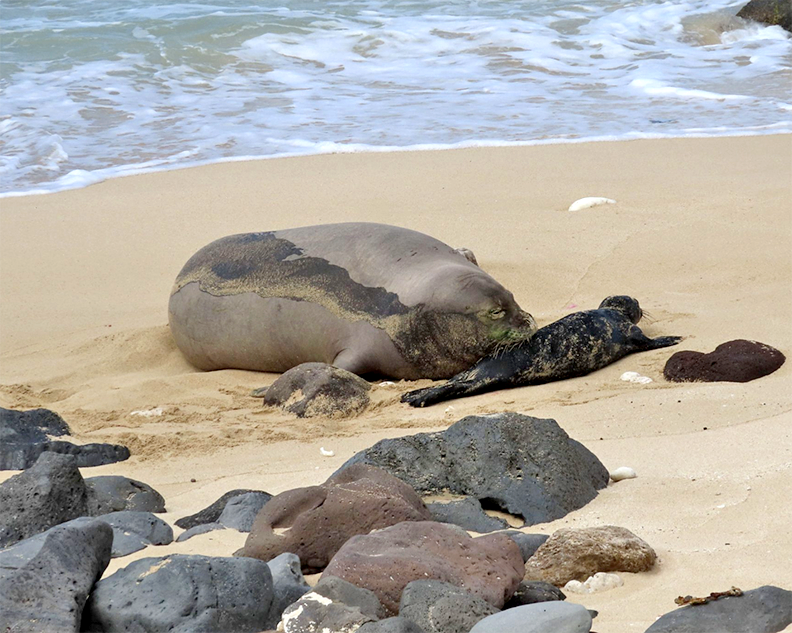
The Western and Eastern garbage patches, and the Subtropical Convergence Zone in the North Pacific Ocean. Image courtesy of NOAA
By Léo Azambuja
We have only began to understand the impacts of plastic on the ocean a few decades ago. The National Oceanic and Atmospheric Administration published a paper in 1988 describing the Great Pacific Garbage Patch, based on studies from Alaska-based researchers who found high concentrations of marine debris in certain areas of established ocean currents.
But this garbage patch described by NOAA was mostly a hypothesis — researchers theorized it based on discoveries in the Sea of Japan, and believed the North Pacific Gyre would likely trap floating waste in areas of relatively stable waters.
Until 1997.
After finishing the Transpacific Yacht Race from California to Hawai‘i in 1997, Capt. Charles Moore decided to take a shortcut home through the North Pacific subtropical ridge. Sailors and fishermen usually avoid this area because of poor fishing grounds and lack of winds.
“As I gazed from the deck at the surface of what ought to have been a pristine ocean, I was confronted, as far as the eye could see, with the sight of plastic. It seemed unbelievable, but I never found a clear spot. In the week it took to cross the subtropical high, no matter what time of day I looked, plastic debris was floating everywhere: bottles, bottle caps, wrappers, fragments,” Moore wrote in the article Trashed, published in the Natural History Journal in 2003 by the American Museum of Natural History.
Months after his 1997 discovery, Moore discussed what he had seen with oceanographer Curtis Ebbesmeyer, one of the world’s leading expert on flotsam. Ebbesmeyer then began referring to the area as the “Eastern Garbage Patch,” Moore wrote. But “patch” doesn’t begin to convey the reality, according to Moore. At that time, Ebbesmeyer estimated that the area was roughly the size of Texas.
Although there is no scientific estimate for the size or mass of the Eastern Garbage Patch, we know today that it has grown much larger than when it was first documented. According to NOAA, more recent reports estimate it to be twice as big as Texas, while other reports believe it to be twice as big as the continental United States.
Additionally, the term “patch” is a bit misleading. It is more like a continental-sized soup made of plastic, Styrofoam and other floating debris, with everything trapped in the same area by ocean currents. And as the plastic breaks down into smaller pieces, it finds its way into the mouth and stomachs of marine life. In other words, plastic in the ocean has become part of the food pyramid.
The Eastern Garbage Patch is just one of many garbage patches in several ocean-current convergences around the globe. In the North Pacific Ocean alone, there is also the Western Garbage Patch and the Subtropical Convergence Zone above Hawai‘i and halfway between the North Pacific patches.
The first fully synthetic plastic, called Bakelite, was invented by Begian-American chemist Leo Baekeland in 1907, using phenol and formaldehyde. BASF first produced polystyrene in the 1930s. Imperial Chemical Industries researchers discovered polyethylene in 1933. Polyethylene terephthalate — the PET plastic in plastic bottles — was discovered by Calico Printers Association in England in 1941. Expanded polystyrene was invented by Dow Chemical in 1954. That same year, polypropylene was discovered by Giulio Natta.
Today, the world produces nearly 300 million tons of plastic each year, and half is for single use, according to the nonprofit organization Plastic Oceans. More than 8 million tons are dumped into the ocean annually.
More than 40 percent of total plastic use is for packaging, according to Plastic Oceans. More than 500 billion plastic bags are used worldwide each year. Sadly, a plastic bag is used an average of 15 minutes before it is discarded.
The Container Recycling Institute reported that 100.7 billion plastic beverage bottles were sold in the U.S. in 2014, with 57.3 billion of those bottles made for plastic water bottles. These numbers are likely higher today. Ironically, producing bottled water requires about six times more water per bottle than the amount of water in the bottle.
About 12 percent of the plastic discarded is burned, and only nine percent is recycled. The rest ends up in landfills and in the natural environment.
It is estimated that by 2050, there will be more trash, pound per pound, than fish in the oceans. And we cannot eat plastic. But we are likely eating plastic byproducts when we eat seafood.
We are beyond the need to recycle plastic. We need to refuse it more often. Have you refused plastic today?
Discover more from ForKauaiOnline
Subscribe to get the latest posts sent to your email.




Leave a Reply